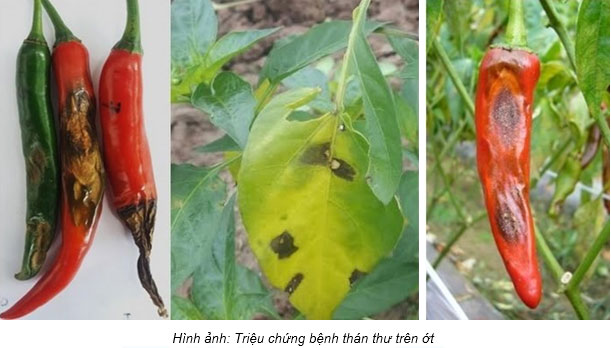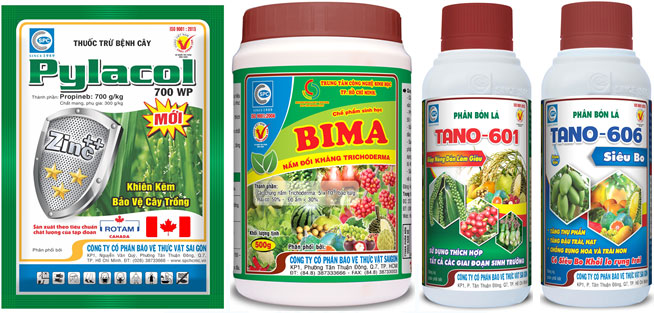|
Care And Prevention Of Anthracnose Disease On Chili Peppers In The Rainy Season
14/08/2021
BSc Tran Thanh Tin Currently, the Mekong Delta is transforming the crop structure with 03 rice crops, only 02 rice crops are left and 01 chili crop, bringing high economic efficiency, improving the soil, and isolating the source of pests and diseases. However, growing chili off-season brings high economic benefits but is disadvantaged due to a number of plant diseases. In the first time, the dry weather affects the growth of seedlings, in the middle of the crop, the plants grow well, but due to the rainy season, it affects flowering and fruit setting, especially pests and diseases affecting the yield and quality of chili peppers. In which, anthracnose disease, also known as fruit spot or fruit burst, is the most common and common disease on chili peppers, affecting very high yields. SYMPTOMS OF DISEASE Anthracnose affects all parts of the chili pepper plant: stem, leaves, fruit and seeds. However, the disease develops strongly and causes severe damage in the mature fruit stage. When the disease first arises, at first the lesions are small, slightly concave spots, the lesions on the fruit are usually slightly wet. After a few days, the lesions grow to a round or oval shape running along the fruit, the lesions are usually 0.6-1.2cm in size. The lesions can link together to cause the fruit to rot, the dry skin is yellowish white and slightly dirty. On the stem of the disease, there is a diamond shape, slightly concave, the boundary between the diseased tissue and the healthy tissue is a black line running along the lesion. There are small black spots on the surface of the lesion. The fungus that causes anthracnose can damage the apical shoots, causing the chili pepper top rot. Damaged shoots are dark brown. Strong growth of the disease can cause the plant to die gradually or the plant to be stunted and slow to grow. On infected plants, the fruit is usually few and the quality is poor. CAUSES OF DISEASE AND DEVELOPMENT CONDITIONS Anthracnose is caused by Colletotrichum gloeosporioides fungus The disease thrives in conditions of high temperature and humidity. Fungal spores are dispersed by wind, insects and irrigation, especially in trench irrigation. Anthracnose spores can germinate in water after 4 hours, the suitable temperature for fungal growth is 28 - 30oC. In our country, anthracnose disease of chili peppers thrives in May-September, when the chili pepper plants are in the fruit-harvesting period. Especially in fields with imbalanced nutrients, low-lying areas, poor drainage, high nitrogen fertilization, causing diseases to arise, develop and cause severe damage. - Anthracnose fungi survive on seeds and diseased plant residues in the form of mycelium and meristem spores. The meristem spores have high vigor and good resistance. Even in hot, dry conditions, although disease remnants are buried in the soil, they can still germinate the following season.
PREVENTIVE MEASURES - Treat seeds in hot water 520C for about 2 hours. - Sow chili peppers at an appropriate density. - Fungi exist in plant residues, need to collect diseased fruits and destroy them. - Rotate crops, do not grow solanaceous plants within 2-3 years. - Select disease-resistant varieties, increase fertilizer application with decomposed manure, and mix with bio-products Bima (containing Trichoderma antagonistic fungi) for chili peppers fields. - Balanced NPK fertilization, especially to fully add trace elements for chili plants, can use Tano 601 foliar fertilizer (N 7%, K 6%, P 7% + MgO 0.05%, Fe 400ppm , Zn 400 Mn 500 ppm, Cu 500 ppm, B 400 ppm, Humic acid 0.3%), periodic spraying every 7-10 days to help plants balance nutrition, enhance resistance, grow fast, flower early, increase the rate of fruit setting. - Especially to help flower early, at the same time, increase pollination rate, prevent flower fall, limit young fruit drop, so mix Super Bo Tano 606 with Tano 601. - Basal Fertilization 3 - 4 kg of Calcium Nitrate fertilizer/1,000 m2 for chili fields and adding 3 - 4 kg/1,000 m2 before flowering also play an important role in limiting anthracnose and fruit rot in the rainy season. - To prevent anthracnose fungus on chili pepper plants, it is necessary to promptly handle the disease when the disease has just started, so spray fungicide containing active ingredient of Propineb, in addition to the direct effect of preventing anthracnose fungus with active ingredient of Propineb. It also adds pure trace element of zinc (Zn++) to chili plants, increases resistance, green and hardy plants, prevents flower and fruit drop, and makes chili pepper fruits bright and beautiful. |
To prevent, in addition to plowing and burying weed seeds, collecting weed stalks and stumps left after tilling the land to burn, not letting weeds produce seeds in production fields, etc., the use of chemical products is still a measure. optimal because of its ability to thoroughly kill weeds, reduce labor and take advantage of more time than manual weeding.
Miner has the scientific name Phyllocnistis citrella Staint., family Phyllocnistidae, order Lepidoptera. The miner occurs in many countries in the tropics and subtropics. The main host of the miner is the citrus family - Rutaceae. In addition, the miner also attacks mangosteen and some other plants.
Adult is a small planthopper, with a body 2-3 mm long, the whole body is ash gray, slightly greenish, the wings are opaque with many small brown spots.Eggs are oval, 0.3 mm long, have a pointed end and are attached directly to the leaf surface, leaf axils.
Green bugs specialize in the fruit of citrus groups (oranges, tangerines, lemons, grapefruits, kumquats...), some people call them orange bugs, or orange suckers. Their scientific name is Rhynchocoris poseidon or Rhynchocoris humeralis.
In Vietnam, yellow leaf curl disease is very common on papaya trees, especially the disease is often severe in areas of high and continuous planting, areas with hot and arid climates. The disease has significantly reduced the yield and quality of papaya. Gardens that are infected early when the plants are young may not yield. However, up to now, many gardeners still do not know the cause and how to fix it.
Spider mites are common pests on citrus trees, especially in hot and dry climates that are suitable for spiders to grow and cause severe damage.The group of harmful spiders is usually very small in size, unlike the natural enemy spiders.
This group includes species that are generally very small in size, causing damage by sucking plant sap (on leaves, fruits, branches, stems).
There are many species of mealybugs present on the group of Oranges,Tangerines,Grapefruits and Lemons (Citrus), which can be divided into 2 groups:
+ Group of sticky mealybugs with common varieties such as Lepidosaphes, Aonidiella, Coccus and Saissetia.
+ Group of flower mealybugs with common genera and species such as Pseudococcus, Planococcus and Icerya purchasi.
Dry branches and berries disease often appear to be common damage on coffee gardens during the rainy season. The disease causes death of branchs, dry fruit, severely affects the canopy structure and coffee yield if not paid attention to prevention.
Pink disease commonly causes diseases on rubber plantations in the rainy season, especially on garden from 4-8 years old. This year, rubber has to go through a period of severe drought, weakening the tree, so now in tnshe rainy season it is easy to get infected. Therefore, it is necessary to pay attention to good management to avoid affecting the garden.
In recent years, the area of citrus has been expanded because it is a fruit tree with high economic efficiency. However, in order to sell at a high price, not only in quality but consumers also require the external beauty of the fruit, so pest management on citrus is a matter of great concern to farmers. The hot season is a favorable condition for thrips to develop and cause damage, affecting the commercial value of fruit.
- Headquarters
- SAIGON PLANT PROTECTION JOINT STOCK COMPANY
- RQ 1, Nguyen Van Quy St., Tan Thuan Ward, HCM City
- Tax code: 0300632232
- Tel: (028) 38 733 295 - 38 732 077
- Fax: (028) 38 733 003 - 38 733 391
- Website: www.spchcmc.vn - Email: info@spchcmc.vn
- SAIGON PLANT PROTECTION COMPANY
- SAIGON PLANT PROTECTION JOINT STOCK ENTERPRISE
- Lot C1-C3 Hiep Phuoc Industrial Park, Hiep Phuoc Commune, HCM City
- Tel: (028) 3873 4089 - Fax: (028) 3873 4086
- Affiliated Unit
-
- Quick Links
- Home
- About us
- Career Opportunities













